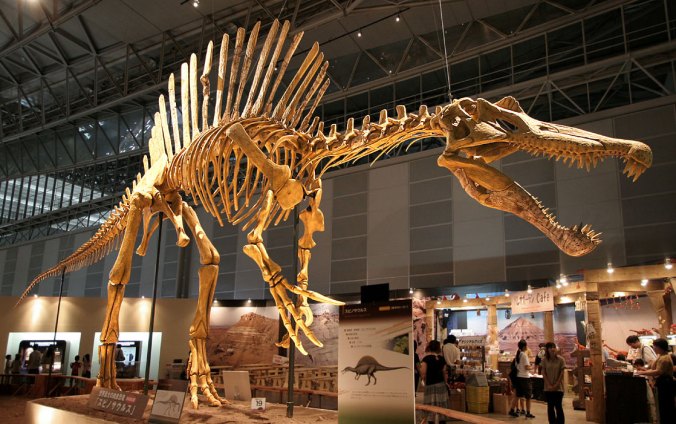
Claims that the Spinosaurus was adapted for a semi-aquatic mode of life have been refuted by new research from the Royal Tyrrell Museum.
In his research, curator of dinosaurs Dr. Donald Henderson, created three-dimensional, digital models of Spinosaurus and other predatory dinosaurs to test the centres of mass buoyancy and equilibrium of the animals when immersed in freshwater. Research published in 2014 by Dr. Nizar Ibrahim and colleagues in Science entitled “Semiaquatic adaptations in a giant predatory dinosaur” proposed that Spinosaurus aegyptiacus was partly aquatic, a first for any dinosaur. This research generated much media attention, and was covered by National Geographic, Discovery Magazine, and other news organizations.
To test this hypothesis, Dr. Henderson used different techniques than the previous research by employing physics-based methods to test whether Spinosaurus was well adapted to living in water.
“Science is self-correcting,” says Dr. Henderson. “Research is a competitive scientific process that continually generates new information and ideas.”
Models were generated of Spinosaurus aegyptiacus, another spinosaurid Baryonyx tenerensis, and four other theropod dinosaurs—Tyrannosaurus rex, Allosaurus fragilis, Struthiominus altus, and Coelophysis bauri.
To ensure that the modelling and software could replicate the orientation and depth of immersion of a living large reptile in water, Dr. Henderson first tested the software using a model of a semi-aquatic American alligator, Alligator mississippiensis. Crocodilians share a common ancestry with theropods and have a long body with a muscular tail that is similar to those of theropods. For completeness, a model of a living, semi-aquatic, predatory theropod, an emperor penguin, was also tested.
Dr. Henderson’s models demonstrated that Spinosaurus could indeed float with its head above water, enabling it to breathe freely; however, the models of other dinosaurs demonstrated similar results. This shows that Spinosaurus was not the only dinosaur capable of floating, which is expected as most terrestrial tetrapods (four-legged animals) can successfully float and swim.
The stability of a Spinosaurus in water was also tested in comparison to the alligator model. When tipped to the side, the alligator model returned to its original topside position. Semi-aquatic animals have the capacity to self-right themselves when floating in water, ensuring that they do not constantly tip over. In contrast, the model of the Spinosaurus rolled over onto its side when tipped slightly. This implies that Spinosaurus would have easily tipped over and would have had to use its limbs constantly to maintain an upright posture in the water.
Additionally, the centre of mass of the digital model of Spinosaurus was found to be close to the hips, similar to what is seen in other theropods. The research by Dr. Ibrahim and colleagues proposed that Spinosaurus had a centre of mass located in the centre of the torso. Dr. Henderson’s new proposed centre of mass is between the hind legs, which enables the body to be balanced when standing or walking. This indicates that Spinosaurus would have still been competent at walking on land.
Dr. Henderson’s models also found Spinosaurus to be unsinkable. Living aquatic birds, reptiles, and mammals all have the ability to submerse themselves to pursue their prey underwater. The inability of a Spinosaurus to sink underwater would severely limit its ability to hunt aquatic prey.
The combination of mass close to the hips, an inability to sink underwater, and a tendency to roll onto its side unless constantly resisted by limb use, suggest that Spinosaurus was not specialized for a semi-aquatic mode of life. “Spinosaurus may have been specialized for a shoreline or shallow water mode of life, but it would still have been a competent terrestrial animal,” stated Dr. Henderson.



























